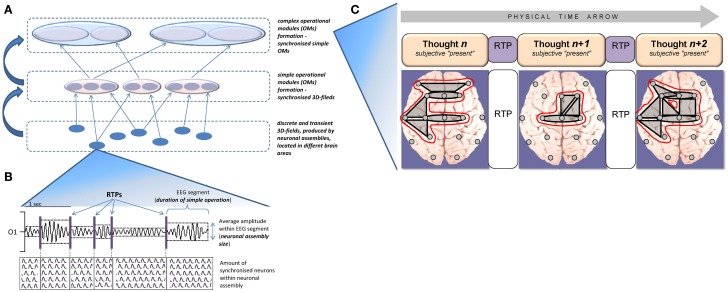Figure 1.
Schematic representation of the nested functional hierarchy of spatiotemporal patterns of 3D electromagnetic fields produced by neuronal assemblies and operational modules formation, as well as their dynamics. (A) In a nested hierarchy, higher levels are physically composed of lower levels, and there is no central control of the system resulting in weak constraint of higher upon lower levels. (B) Illustration of the neuronal assembly's dynamic and its relation to the EEG signal segments (for methodological details see Fingelkurts and Fingelkurts, 2008, in press); RTP, rapid transitional processes. Local EEG signal (O1-left occipital location) is filtered in alpha (7–13 Hz) frequency band. (C) Diagram depicting dynamics of operational modules (OMs). Phenomenological level of description illustrates the ever-changing stream of consciousness, where each momentarily stable pattern is a particular kaleidoscopic image separated from one another by the transitive fringes (or rapid transitional periods; RTPs). Neurophysiological level is presented by a relatively stable complex OMs (outlined by the red line), that undergo abrupt changes simultaneously with changes in phenomenological level. Such abrupt changes marked as rapid transitional periods (RTPs). Gray shapes illustrate simple OMs. This scheme is based on data published in Fingelkurts et al. (2003). Methodological aspects of how 3D electromagnetic fields and their combination in the form of operational modules are extracted from EEG could be found in Fingelkurts and Fingelkurts (2008, in press).

